The Last Dinosaur Chomps Your Nostalgia on Warner Archive DVD
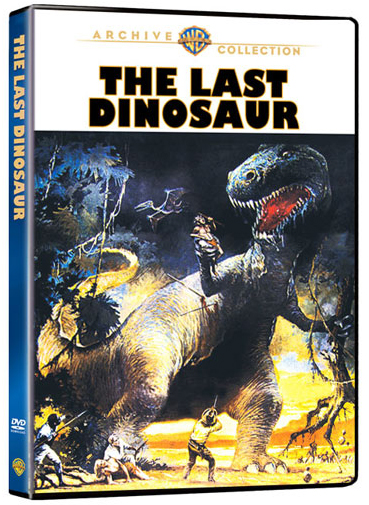 It follows that if I write about The Bermuda Depths and its manufacture-on-demand DVD release, I must also write about its sister film, the dinosaur-hunting marvel of a Saturday afternoon dreamland, 1977’s The Last Dinosaur — also available on MOD DVD from Warner Archive. “Richard Boone vs. a T. Rex in a Primeval World.” You don’t need a large marketing team to work on your movie if you have a tagline like that.
It follows that if I write about The Bermuda Depths and its manufacture-on-demand DVD release, I must also write about its sister film, the dinosaur-hunting marvel of a Saturday afternoon dreamland, 1977’s The Last Dinosaur — also available on MOD DVD from Warner Archive. “Richard Boone vs. a T. Rex in a Primeval World.” You don’t need a large marketing team to work on your movie if you have a tagline like that.
The Last Dinosaur is a 1950s giant monster movie filmed in the 1970s and filtered through the visual effects style of 1960s Japanese special effects (tokusatsu) films. If that sentence gives you a frisson of joy, then the movie won’t disappoint. And The Last Dinosaur is a touch better than that description suggests, with a solid script and an excellent main character who can carry the outrageousness of a giant monster movie and make it seem like Moby Dick.
Touring around the ‘net looking for reviews of The Last Dinosaur will mostly unearth “bad movie snark” having a laugh over its economical special effects. You won’t find much of that here: I think The Last Dinosaur is a top-shelf B-budgeted “lost world” film that delivers all it should, occasional chuckles and groans included. Make all the sly comments you want about the “man-in-suit” monster effects — and there are some amusing moments — they still offer far more creativity and fun than most CGI-driven contemporary movies. Compare The Last Dinosaur to anything from SyFy and you’ll see the talent we lost when the Machines won the war.
Shot in Japan at the same time Amicus Productions in the U.K. was making their Edgar Rice Burroughs adaptations (The Land That Time Forgot, At the Earth’s Core, The People That Time Forgot), The Last Dinosaur sports a similar style that captures the spirit of ERB within a contemporary setting. It’s the best Edgar Rice Burroughs adaptation not actually based on one of his novels; if Burroughs were alive and writing in the 1970s, he might have written something just like this.
The Last Dinosaur was the first co-production between Rankin/Bass and Japan’s Tsubaraya Productions; it is far more a “Japanese giant monster” movie (kaiju eiga) than The Bermuda Depths made the next year. It went to theaters in Japan under the title Kyokutei Tankensen Pora-Bora, and was also slated for a theatrical release in the U.S. But at the last minute it was re-purposed as an ABC Movie of the Week, edited to fit the two-hour slot with commercials. As much as The Last Dinosaur deserved a wide stateside release, or even a limited one, in 1977 this style of low-budget adventure film was on the verge of vanishing because of the Star Wars assault. Ray Harryhausen’s penultimate film, Sinbad and the Eye of the Tiger, lost business because of its proximity to Star Wars, and The Last Dinosaur would have likely suffered the same fate. (It doesn’t help that Sinbad and the Eye of Tiger is one of Harryhausen’s poorest; I’d rather watch The Last Dinosaur any day of the week.)
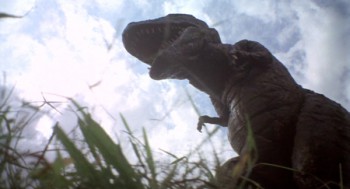 The story puts together pieces from At the Earth’s Core, The Land That Time Forgot, Arthur Conan Doyle’s The Lost World, and any number of H. R. Haggard books, and transposes them into the late ‘70s. Richard Boone at the cigarette butt end of his career plays Masten Thrust: billionaire owner of Thrust Enterprises, womanizer, big game hunter, and the last of his kind — or so the theme song loudly proclaims. We first see Thrust in his private jet entertaining another in a string of brief female companions, but he’s lost his zest for life. Where is the next big game to hunt in a world where he has conquered everything?
The story puts together pieces from At the Earth’s Core, The Land That Time Forgot, Arthur Conan Doyle’s The Lost World, and any number of H. R. Haggard books, and transposes them into the late ‘70s. Richard Boone at the cigarette butt end of his career plays Masten Thrust: billionaire owner of Thrust Enterprises, womanizer, big game hunter, and the last of his kind — or so the theme song loudly proclaims. We first see Thrust in his private jet entertaining another in a string of brief female companions, but he’s lost his zest for life. Where is the next big game to hunt in a world where he has conquered everything?
How about … a dinosaur safari? One falls in his lap after the destruction of a Thrust Enterprises “polar borer,” vehicles engineered to drill for oil under the ice caps. The only survivor of the disaster, geologist Chuck Wade (Steven Keats, best known for playing Charles Bronson’s son-in-law in Death Wish) brings back the incredible story that Polar Borer V drilled up into the base of an Arctic volcano and found a tropical land inside. The wonder lasted a few minutes before a Tyrannosaurus rex chomped down on Wade’s four crew members. “There’s no mistaking that species from that distance,” Wade says, hinting that he’s spent plenty of time observing live T. rexes across the globe instead of looking at their skeletons.
But Wade’s word is good enough for hunt-happy Masten Thrust. The tycoon announces plans to mount an expedition in Polar Borer VI to return to the volcano basin and capture the Tyrannosaur. At the urging of world famous biologist Dr. Kawamoto (Tetsu Nakamura), Thrust promises that he will not harm this last survivor of the Mesozoic. Of course, he’s lying: Thrust wants to mount the jumbo T. rex skull on his wall, and he’ll endanger everyone else on his team once they get deep into the dino-fracas.
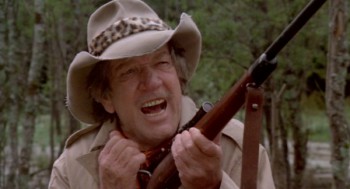 Aboard Polar Borer VI with Thrust are Chuck Wade, photo journalist Francesca “Frankie” Banks (‘70s TV staple Joan Van Ark), Dr. Kawamoto, and Thrust’s faithful hunting buddy, the silent Bunta (Luther Rackley). Thrust originally objects to having Frankie along out of old-fashioned sexism. Then she flirts with him and strips behind a bush, and he’s still an old-fashioned sexist, but now he’s horny and so he lets her come along.
Aboard Polar Borer VI with Thrust are Chuck Wade, photo journalist Francesca “Frankie” Banks (‘70s TV staple Joan Van Ark), Dr. Kawamoto, and Thrust’s faithful hunting buddy, the silent Bunta (Luther Rackley). Thrust originally objects to having Frankie along out of old-fashioned sexism. Then she flirts with him and strips behind a bush, and he’s still an old-fashioned sexist, but now he’s horny and so he lets her come along.
Soon after the team enters the tropical wonderland of the volcano, the Tyrannosaur punches Dr. Kawamoto’s ticket. This seems odd since the doctor was set up as the opposition to Thrust’s lust to kill to creature. Oh well; somebody had to go down the gullet first to establish that the dinosaur is serious about being the ultimate carnivore. The Tyrannosaur also wrecks base camp and carries off the borer to bury it. (Shiny object!) The surviving expedition members find themselves trapped in this lost world without any weapons. Have you ever tried to kill a Tyrannosaur with an unstrung tennis racket? It takes a lot of work.
While Wade and Frankie try to locate the borer and get it back to the lake so they can escape before the support team outside the volcano pulls up anchor and goes home, Thrust dives into his insane Great White Hunter act and tries his best to get everyone killed with his schemes. Thrust’s mindset comes down to “Kill dinosaur first, then escape.” He hatches some Wile E. Coyote/Gilligan’s Isle schemes to do it: attach a boulder to its tail, build a catapult, etc.
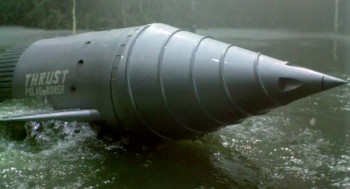 The Tyrannosaur and Thrust’s obsession aren’t the only dangers. Despite the title, there’s more than one prehistoric beast in the basin: Pterodactyls, a big turtle, a triceratops, and a rhino-like creature that Wade calls a “ceratopsian” even though it doesn’t remotely look like one. There is also a primitive human tribe that hates the intruders who are encroaching on their limited food supply. We know they’re primitive because they walk hunched over all the time.
The Tyrannosaur and Thrust’s obsession aren’t the only dangers. Despite the title, there’s more than one prehistoric beast in the basin: Pterodactyls, a big turtle, a triceratops, and a rhino-like creature that Wade calls a “ceratopsian” even though it doesn’t remotely look like one. There is also a primitive human tribe that hates the intruders who are encroaching on their limited food supply. We know they’re primitive because they walk hunched over all the time.
William Overgard’s script is better work than this sort of B-adventure material usually receives, building up interesting characters and internal conflicts to keep the wild prehistoric adventure on track. Except for a rocky middle section when the uninteresting tribe threatens the Polar Borer team, the script paces out the drama to keep viewers involved up to the final showdown between Masten Thrust and the Tyrannosaur, followed by the semi-tragic coda. Overgard also had a knack for giving Richard Boone the perfect lines to chew on in madman crank mode. When an employee informs Thrust that the board of investors unanimously chose Frankie to go on the mission, he steadily replies: “Well they will have to get un-unanimous and un-choose her.” (Great Boone-delivery helps sell it).
Boone holds the film together and makes the human half of the story more interesting than viewers have any right to expect. He’s an intriguing mixture of Howard Hughes and Quint from Jaws with a sprinkle of Count Zaroff from “The Most Dangerous Game” and Alan Quartermain from King Solomon’s Mines. Boone was a superb actor who anchored one the greatest television Western series, Have Gun — Will Travel, and even in his ragged old age (Boone’s flinty handsomeness had changed to “Old Man of Mountain” by the late ‘70s) he had fantastic presence and the skill to deliver an over-the-top character at the right elevation, shouting insults and ultimatums at the least provocation. He can even handle shouting “You ding-dong!” at Wade and make it sound convincing. (Okay, so Overgard’s script has a few clunker lines. This moment at least deserved some Internet meme status.) Boone would continue his association with Rankin/Bass in 1977 when he voiced Smaug for the animated version of The Hobbit.
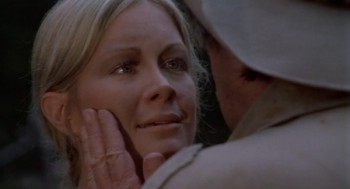 Michael Keats and Joan Van Ark come across far too “TV-movie actor” in their roles, especially placed beside a showman like Richard Boone. Boone was a TV actor from a different era, and it shows. Keats plays Chuck Wade as an obstructionist whiner, and Van Ark’s Frankie ends up bolstering Thrust’s worst sexism by acting empty-headed and eventually shrewish. Of course, Wade and Frankie end up together; not only are they suited for each other, it’s hard to accept Joan Van Ark ending up with a leathery and unhinged Richard Boone.
Michael Keats and Joan Van Ark come across far too “TV-movie actor” in their roles, especially placed beside a showman like Richard Boone. Boone was a TV actor from a different era, and it shows. Keats plays Chuck Wade as an obstructionist whiner, and Van Ark’s Frankie ends up bolstering Thrust’s worst sexism by acting empty-headed and eventually shrewish. Of course, Wade and Frankie end up together; not only are they suited for each other, it’s hard to accept Joan Van Ark ending up with a leathery and unhinged Richard Boone.
Van Ark manages to rise up to Boone’s level once, near the end of the film in the single best human-interaction scene. Frankie begs Thrust to return with them to civilization in the borer and drop his mad plan for a final confrontation with the Tyrannosaur. Thrust refuses and falls into a mumbling wish for Frankie to remain with him as his “Eve.” She promises to be his Eve if he comes back with her. It is completely out of character for Frankie — Masten has spent the previous ninety-plus minutes condescending to her — but it’s a meaty moment in a film that has grown increasingly dark and desperate.
There isn’t much of a supporting cast outside of the three leads: Luther Rackley’s silent Bunta is a bit of exotic garnish to emphasize Thrust’s safari hunter image. Testu Nakamura, after a career in classic Japanese SF movies like Mothra and Atragon, as well as the not-so-classic Space Amoeba and the nutball Latitude Zero (A film I ought to get to on Black Gate some day), gives his last film performance as Dr. Kawamoto. Nakamura feels wasted in what could have been the “rational scientist” role when he ends up in the “first victim” role instead. He does go out on a cinematic high note: a great POV shot of the Tyrannosaur’s foot coming down and blacking out the screen. Masumi Sekiya plays “Hazel,” a woman from the tribe who becomes fascinated with the newcomers and Thrust in particular, but her part feels underwritten and missing a major beat somewhere in the last third. William Ross, the owner of Frontier Enterprises that handled English dubbing for many Japanese SF movies, appears as the Mother 1 Chief Technician, “Hal.”
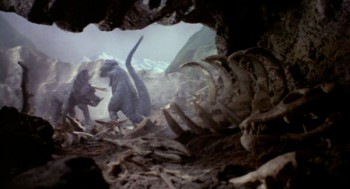 The visuals in The Last Dinosaur are a perfect example of how children view special effects. When I first saw the movie as a five-year-old, the Tyrannosaurus rex looked shockingly real to me. Today it looks like exactly what it is: a loveable man-in-a-suit. It’s an awkward suit as well, with a head that flops around too much and a clumsy gait. But I think it’s beautiful. The VFX team photographs it in clever ways, using numerous low-angle shots to emphasize its size and menace. The handmade charm of the thing gives it a personality that makes Thrust’s obsessed quest against it seem quasi-sensible.
The visuals in The Last Dinosaur are a perfect example of how children view special effects. When I first saw the movie as a five-year-old, the Tyrannosaurus rex looked shockingly real to me. Today it looks like exactly what it is: a loveable man-in-a-suit. It’s an awkward suit as well, with a head that flops around too much and a clumsy gait. But I think it’s beautiful. The VFX team photographs it in clever ways, using numerous low-angle shots to emphasize its size and menace. The handmade charm of the thing gives it a personality that makes Thrust’s obsessed quest against it seem quasi-sensible.
The effects show their seams the most during sequences that need to have the Tyrannosaur and the humans in the same shot. The image quality drops from the optical printing, and harsh lines often appear to halo the dinosaur. A few split-screen effects alleviate this, but it’s easier to feel the Tyrannosaur threatening the heroes through editing rather than having them appear on screen together.
The Tyrannosaur gets a few “solo” scenes with no humans to get in the way, and the effects are most imaginative and enveloping here: The confrontation with the Triceratops that was inexplicably sleeping inside a cliff face is near-perfect Saturday matinee wonder. The two foes, classic enemies in the imagination of all children, square off in a pit of bones and gore and bite each other to the death — good stuff. There’s also a short sequence of the dinosaur catching fish from a stream that is quite lovely, and gives the feeling of a real animal instead of a fantasy creature. When Frankie at the end of the movie begs Thrust to leave the creature alone “because it’s the last,” these brief moments of the Tyrannosaur living its daily life suddenly mean something. Yeah, Thrust, screw off: let the dinosaur just be a dinosaur.
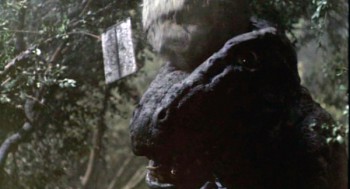 The effects can be cheesy, but they show imagination end effort, and that counts the most for a film from this era. They’re also omnipresent, starting from the model of Thrust’s private jet in the pre-credits sequence. More is definitely more when it comes to Tsubaraya Production’s style of effects. But there is one infamous VFX glitch that I can’t pass up mentioning because it’s a gobstopper of MST3K hilarity. When Thrust unleashes his jerry-rigged catapult at the Tyrannosaur, the hurtling boulder makes a direct hit on the saurian’s skull, causing the rubber and latex head to dent in and then rebound. You know, just like real skulls do. But this is a metaphor for the whole film: even if something silly happens (“You ding-dong!”), the movie bounces right back and the silliness just becomes another thing to enjoy.
The effects can be cheesy, but they show imagination end effort, and that counts the most for a film from this era. They’re also omnipresent, starting from the model of Thrust’s private jet in the pre-credits sequence. More is definitely more when it comes to Tsubaraya Production’s style of effects. But there is one infamous VFX glitch that I can’t pass up mentioning because it’s a gobstopper of MST3K hilarity. When Thrust unleashes his jerry-rigged catapult at the Tyrannosaur, the hurtling boulder makes a direct hit on the saurian’s skull, causing the rubber and latex head to dent in and then rebound. You know, just like real skulls do. But this is a metaphor for the whole film: even if something silly happens (“You ding-dong!”), the movie bounces right back and the silliness just becomes another thing to enjoy.
Maury Law’s music is overactive with its electronic sting that repeats again and again, but it’s also insanely catchy. The theme song, “The Last Dinosaur,” is an attractively wistful melody. The vocal version with lyrics by Jules Bass that plays over the main and end titles, sung in pseudo-Shirley Bassey style by Nancy Wilson, highlights the identification between Thrust and the title a bit too firmly (“He is the last, there are no more / He is the last di-no-saur!”), but like so much else in this film, the song is designed to linger in young minds for eternity.
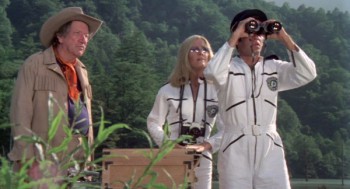 The Last Dinosaur shares with The Bermuda Depths a downbeat, mournful ending; in both films, the monster gets to “win.” But where the conclusion of The Bermuda Depths is muddled and arbitrary, The Last Dinosaur earns its inevitable conclusion, one that rises out of stronger characterizations. Only the 1970s could get away with this sort of glum fadeout. It leaves a lasting impression, even for viewers who may not enjoy the rest of the movie.
The Last Dinosaur shares with The Bermuda Depths a downbeat, mournful ending; in both films, the monster gets to “win.” But where the conclusion of The Bermuda Depths is muddled and arbitrary, The Last Dinosaur earns its inevitable conclusion, one that rises out of stronger characterizations. Only the 1970s could get away with this sort of glum fadeout. It leaves a lasting impression, even for viewers who may not enjoy the rest of the movie.
The cut of the movie on the Warner Archive DVD is the theatrical release version that runs 106 minutes. It was cut down to nearly ninety minutes for its ABC-TV premiere. My memories of seeing the film in ‘70s are too blurry to tell what was put back in, and the bootleg I saw about seven years ago was taken from an uncut Japanese laserdisc, so I have no idea what comprises the restored fifteen minutes. The MOD DVD has a better than average transfer, presented in anamorphic 1.85:1 to match its theatrical release. Like other Warner Archive discs, there are no bonus features. The menu is a generic image with one option, “PLAY MOVIE,” and chapter stops are not scene-specific but spaced out every ten minutes. Please don’t let this barest of bones presentation stop you from seeing/re-visiting a lost ‘70s giant monster classic.
Ryan Harvey is a veteran blogger for Black Gate and an award-winning science-fiction and fantasy author who knows Godzilla personally. He received the Writers of the Future Award in 2011 for his short story “An Acolyte of Black Spires,” and his story “The Sorrowless Thief” appears in Black Gate online fiction. Both tales place in his science fantasy world of Ahn-Tarqa. A further Ahn-Tarqa adventure, “Farewell to Tyrn”, the prologue to the upcoming novel Turn Over the Moon, is currently available as an e-book. You can keep up with him at his website, www.RyanHarveyWriter.com, and follow him on Twitter.
I mostly remember the boulder tied to the tail (hilarious) and the boulder to the head (comedy gold). I don’t remember a solid script though.
[…] a way to merge my recent posts about the manufacture-on-demand DVDs of The Bermuda Depths and The Last Dinosaur with my long-running Edgar Rice Burroughs posts. Tarzan’s Greatest Adventure, the 1959 […]
[…] (Yeah, you own a couple of those.) Tarzan’s Greatest Adventure, The Bermuda Depths, and The Last Dinosaur all come from Warner Brothers’ MOD division. But two other studios have their own extensive MOD […]
Excellent read, thank you Ryan. The nostalgia is strong with this film.